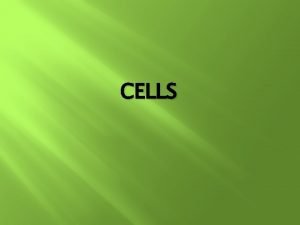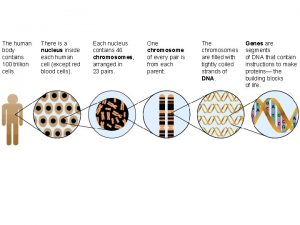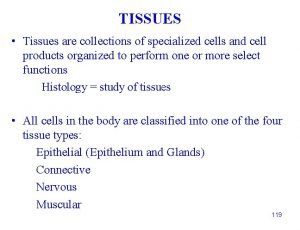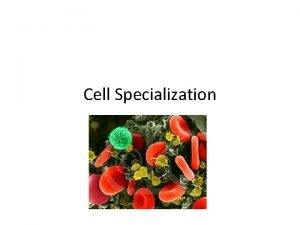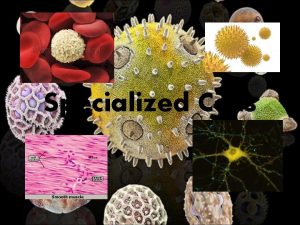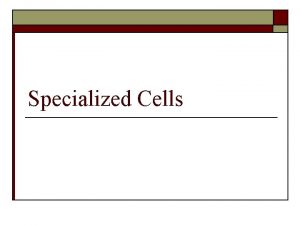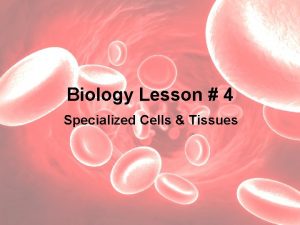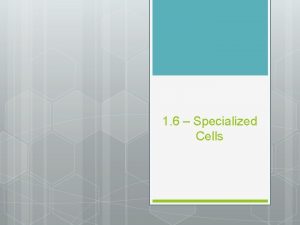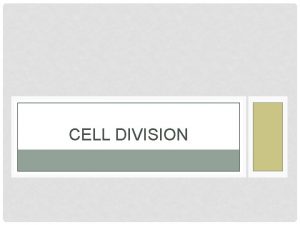Specialized Cells 50 75 Trillion cells in your


















- Slides: 18

Specialized Cells • 50 – 75 Trillion cells in your body • 220 specialized cells – Heart – Nerve – Blood – Sperm – Etc. • Why different?

Specialized Cell • A cell that has a particular structure and performs a specific function • Each type has unique shape, size and features allowing it to do its job accurately

• The cells in animals are not all identical. • They perform specific functions, such as delivering oxygen and fighting disease, moving the skeleton, storing energy or coordinating the whole body.

• Plant cells also have a variety of specialized cells. Cells in the leaf of a tree have a different structure and function from the cells in the trunk.

Example: Trachea Cilia (don’t copy into notes) • Specialized cells have physical and chemical differences that allow each type to perform one job very well. • These cells help keep dirt out of the lungs. – The orange goblet cells secrete mucus – The hair-like extensions (called cilia) move the mucus along the trachea to remove inhaled dust and dirt.

Examples: 1. Red Blood Cell – Round edges to travel in blood vessels easier – No nucleus = more room to carry O 2 and CO 2

2. Nerve Cell – Long, skinny arms to send messages quickly over long distances

3. Ear Cells – have cilia – tiny hairs on inner ear cells that pick up vibrations in the air and send signal to brain.

4. Muscle Cell – Long, skinny cells that lengthen and shorten to move muscles

Stem Cells • Unspecialized cells that divide quickly and do not have a particular function yet.

Specialized Cells

• Only stem cells can differentiate into many cell types.

Where are Stem Cells?

Cord Blood Cell Banking? • The blood found in an umbilical cord immediately after the birth of a child is a rich source of stem cells. • These stem cells can develop into various kinds of blood cells. • The blood collected from the cord can be banked (or stored) in the event it is needed later in the child’s or a sibling’s life.

How can Stem Cells be Used? • For diseases such as leukemia, stem cells collected from healthy blood can be injected into a patient’s blood after the diseased cells have been killed. • The healthy cells then grow in the patient’s bone marrow and produce healthy, cancer-free blood cells. • http: //www. dnalc. org/resources/animations/stemcells. html • http: //youtu. be/O 5 r-T 6 ANKto

To Do Now: • Draw 2 Different types of cells that you find under the microscope.


To Do Now: • Draw 2 Different types of cells that you find under the microscope. TO FOCUS MICROSCOPE: • Start on smallest power lens, focus in on cell. • Go to medium power and focus • Go to high power and focus if possible.
 100 trillion cells
100 trillion cells 100 trillion cells in the human body
100 trillion cells in the human body Collection of specialized cells and cell products
Collection of specialized cells and cell products Specialized cells in animals
Specialized cells in animals Specialized cells
Specialized cells What does trillion dollars look like
What does trillion dollars look like Hundred thousand million billion trillion
Hundred thousand million billion trillion Counting large numbers
Counting large numbers Exchanges over trillion trading volume this
Exchanges over trillion trading volume this Lathrop intermediate
Lathrop intermediate 600 trillion dollars
600 trillion dollars Give us your hungry your tired your poor
Give us your hungry your tired your poor Sphenoid paranasal sinus
Sphenoid paranasal sinus Principal cells vs intercalated cells
Principal cells vs intercalated cells Thyroid parafollicular cells
Thyroid parafollicular cells Gamete vs somatic cell
Gamete vs somatic cell Why dna is more stable than rna?
Why dna is more stable than rna? Red blood cells and white blood cells difference
Red blood cells and white blood cells difference Prokaryotic vs eukaryotic cells worksheet
Prokaryotic vs eukaryotic cells worksheet
